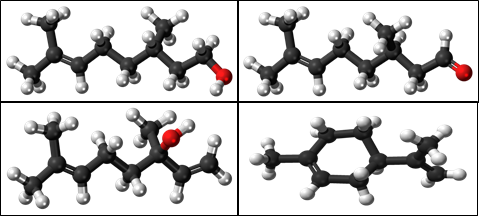Aakanksha Wany, Shivesh Jha, Vinod Kumar Nigam, Dev Mani Pandey. "CHEMICAL ANALYSIS AND THERAPEUTIC USES OF CITRONELLA OIL FROM CYMBOPOGON WINTERIANUS : A SHORT REVIEW." International Journal of Advanced Research 1, no. 6, 2013: 504-521.
Almeida, R.N., Navarro, D.S., Barbosa-Filho, J.M. "Plants with central analgesic activity. Phytomed." Phytomedical, 2001: 310-322.
Bond, C., K. Buhl, and D Stone. Citronella General Fact Sheet. Oregon, USA: National Pesticide Information Center, Oregon State University Extension Services., 2013.
Bruno Guandalini Cunha, Cristiane Duque, Karina Sampaio Caiaffa, Loiane Massunari, Isabela Araguê Catanozea, Daniela Micheline dos Santos, Sandra Helena Penhade Oliveira, Aimée Maria Guiotti. "Cytotoxicity and antimicrobial effects of citronella oil (Cymbopogon nardus) and commercial mouthwashes on S. aureus and C. albicans biofilms in prosthetic materials." Archives of Oral Biology 109, 2020.
Choochote, W., Chaithong, U., Kamsuk, K., Jitpakdi, A., Tippawangkosol, P., Tuetun, B., Champakaew, D., Pitasawat, B. "Repellent activity of selected essential oils against Aedes aegypti." Fitoterapia, 2007: 359-364.
Curtis CF, Lines JD, Ijumba J, Callaghan A, Hill N, Karimzad MA. "The relative efficacy of repellents against mosquito vectors of disease." Medical & Veterinary Entomology, 1987: 109-119.
EPA. Registration Eligability Descision Document: Oil of Citronella. US EPA, n.d.
Fatehia Nasser Gharsan, Walaa Mohamed Kamel, Tariq Saeed Alghamdi, Azla Aedh Alghamdi, Abeer Olayana Althagafi, Sameera NasserAl-Ghamdi, Fatima Jasim Aljassim. "Toxicity of citronella essential oil and its nanoemulsion against the sawtoothed grain beetle Oryzaephilus surinamensis (Coleoptera: Silvanidae)." Chemical composition of the analyzed citronella essential oils 184, 2022.
Fradin, M.S. "Mosquitoes and mosquito repellents: a clinician‟s guide." Annals of Internal Medicine, 1998: 931-940.
G, Covell. "Anti-mosquito measures with special reference to India." Health Bulletin, 1943.
Goodyer LI, Croft AM, Frances SP, Hill N, Moore SJ, Onyango SP, Debboun M. "Expert review of the evidence base for arthropod bite avoidance." Journal of Travel Medicine, 2010: 1708-8305.
Jaroenkit, P., Matan, N., Nisoa,M. "In vitro and in vivo activity of citronella oil for the control of spoilage bacteria of semi dried round scad (Decapterus maruadsi)." International Journal of Medicinal and Aromatic Plants, 2011: 234-239.
Maia, M.F., Moore, S.J. "Plant-based insect repellents: a review of their efficacy, development and testing." Malaria Journal, 2011.
Miro Specos MM, Garcia JJ, Tornesello J, Marino P, Della Vecchia M, Defain Tesoriero MV, Hermida LG. "Microencapsulated citronella oil for mosquito repellent finishing of cotton textiles." Transactions of the Royal Society of Tropical Medicine and Hygiene, 2010: 653-658.
Moore SJ, Hill N, Ruiz C, Cameron MM. "Field Evaluation of Traditionally Used Plant-Based Insect Repellents and Fumigants Against the Malaria Vector Anopheles darlingi in Riberalta, Bolivian Amazon." Journal of Medical Entomology, 2007: 624-630.
Murugan, V.K., Masthan, M. K., Vediappan, V. K. "Potential and controlled repellent activity of microencapsulated citronella oil treated textile cotton fabrics against Aedes aegypti." Journal of Bioscience and Bioengineering, 2012.
Nakahara, K., Alzoreky, N.S., Yoshihashi, T., Nguyen, H.T.T., Trakoontivakorn, G. "Chemical composition and antifungal activity of essential oil from Cymbopogon nardus (citronella grass)." Japan Agriculture Research Quaterly, 2003: 249-252.
Olivo, C.J., Carvalho, N.M., de, Silva, J.H.S., da, Vogel, F.F., Massariol, P., Meinerz, G., Agnolin, C., Morel, A.F., Viau, L.V.,. "Óleo de citronella no controle do carrapato de bovinos." Revista Ciência Rural, 2008: 406-410.
PP Papulwar, BU Rathod, NR Dattagonde. "Studies on insecticidal properties of citronella grass (lemon grass) essential oils against gram podborer (Helicoverpa armigera)." International Journal of Chemistry Studies 2, no. 1, 2018: 44-46.
Rani, N., Wany, A., Vidyarthi, A.S., Pandey, D.M.,. "Study of Citronella leaf based herbal mosquito repellents using natural binders,." Current Research in in Microbiology and Biotechnology, 2013: 98-103.
Sakulku U, Nuchuchua O, Uawongyart N, Puttipipatkhachorn S, Soottitantawat A, Ruktanonchai U. "Characterization and mosquito repellent activity of citronella oil nanoemulsion." International Journal of Pharmacology, 2009: 105-111.
Shasany, A.K., Lal, R.K., Darokar, M.P., Patra, N.K., Garg, A., Kumar, S., Khanuja, S.P.S.,. "Phenotypic and RAPD diversity among Cymbopogon winterianus Jowitt accessions in relation to Cymbopogon nardus." Genetic Resources and Crop Evolution , 2000: 553 - 559.
Tawatsin A, Wratten SD, Scott RR, Thavara U, Techadamrongsin Y. "Repellency of volatile oils from plants against three mosquito vectors." Journal of Vector Ecology, 2001: 76-82.
Trongtokit Y, Rongsriyam Y, Komalamisra N, Apiwathnasorn. "Comparative repellency of 38 essential oils against mosquito bites." Phytotherapy Research, 2005: 303-309.
Weilan Li, Hongyan Liu,Qiong Xu. "Extracellular Dextran and DNA Affect the Formation of Enterococcus faecalis Biofilms and Their Susceptibility to 2% Chlorhexidine." Journal of Endodontics, 2012: 894-898.
Wong, K.K.Y., Signal, F.A., Campion, S.H., and Motion, R.L.,. "Citronella as an insect repellent in food packaging." Journal of Agricultural and Food Chemistry 53, no. 11, 2005: 4633-4636.



